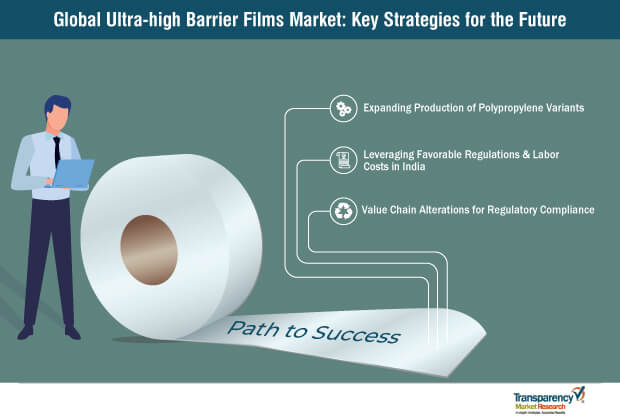
Ultra-high Barrier Films: Breaking Barriers in Flexible Packaging
With every aspect of human life becoming smarter and more intelligent, packaging is not too far behind. The perpetual rise in consumer expectations has been influencing a wide-range of industries to prioritize the upgrading process of their products as well as systems to offer an exceptional consumer experience, and the packaging sphere is no exception. As the adoption of flexible packaging is constantly on an upward swing, manufacturers of packaging films are emphasizing on developing new structures and composition to fulfil the increasingly demanding requirements of brand owners and consumers.
In view of this evolutionary landscape, new developments in the packaging industry in general, and the ultra-high barrier films market in particular, Transparency Market Research, in its new study, explores the tailwinds and headwinds of the ultra-high barrier films market, and brings to fore actionable insights to assist market stakeholders in critical decision-making.

Planning to lay down future strategy? Perfect your plan with our report brochure here
Ultra-high Barrier Films Market Evolves with Changing Consumer Behavior
No major advancements were made in the packaging industry until the introduction of plastic in the 1900s, which has brought a sea change to the industry. Rapid expansion of end-use industries, especially food & beverages, has been working in tandem with continuous developments of new packaging materials and barrier films, including those with high moisture barrier (HMB), high speed barrier (HSB), and ultra-high barrier (UHB). The demand for ultra-high barrier films thrived with the growing need for preserving, protecting, and extending the shelf life of processed food and sensitive products. In 2018, the global sales of ultra-high barrier films closed in on US$ 1.2 billion, and the number of manufacturers vying for a share of this lucrative market has been growing over the years.
Although ultra-high barrier films have been successful in fulfilling the consumer quest for convenience, rising intolerance for plastics and the cloud swirling around sustainability in recent years are putting manufactures to the test. In addition, strategic initiatives of market players are highly influenced by rapid advancements in the processed food industry and expansion of e-commerce sites as the modern sales channel.
Manufacturers Shifting Focus Away from Plastics
As flexible packaging takes over traditionally-preferred rigid packaging of food and other products, manufacturers remain inclined towards the production of flexible and barrier films. While the industry-wide prevalence of different forms of plastics continues to work well with product development strategies in the ultra-high barrier films market, key manufacturers are shifting focus on the use of recyclable materials such as aluminum and aluminum oxide to address the rising concerns regarding the harmful impacts of plastic-filled oceans and surroundings.
Want to know the obstructions to your company’s growth in future? Request a PDF sample here
The adoption of ultra-high barrier films continues to remain robust across different sectors of the food industry, and is further driven by the penetration of ready-to-eat meals in tune with a surge in the number of working individuals across the globe. With a notable rise in the number of quick service restaurants (QSRs) and their great efforts to deliver an on-the-go experience, manufacturers of ultra-high barrier films are focusing on leveraging the opportunities created across the spectrum of the food industry. Enhancing the barrier properties while minimizing the weight of the films also remains key focus areas of manufacturers.
Multimodal Approach to Win in the Ultra-high Barrier Films Market
Focus on Developing Countries
As the packaging industry is witnessing a paradigm shift towards the untapped markets in developing countries, where operating costs are relatively low, ultra-high barrier film manufacturers are eyeing the market opportunities in these countries. A transition from traditional markets to the purchasing of packaged consumer goods in Asia Pacific, led by China and India, accounts for a potential business prospect for key market players. In addition, a wave of small size packaging as opposed to large quantities emerging in the Middle East & African countries, due to reduced consumer spending capacity, is further influencing manufacturers to build effective strategies that align with these situations.
Looking for exclusive market insights from business experts? Request a Custom Report here
Innovations to Align with Technological Trends
Product innovations have also been forthcoming with the emergence of modern packaging techniques such as vacuum skin packaging (VSP) and modified atmosphere packaging (MAP) that use high barrier packaging materials. Additionally, considering the difficulty in recycling and disposing ultra-high barrier films, along with government regulations for enhancing environmental conservation practices, market players are launching products that meet the new standards set by the recycling community. These factors were put forward when Amcor Limited, a key ultra-high barrier films market player, launched its AmLite Ultra Recyclable, a high metal-free barrier laminate that significantly reduces the carbon footprint of packaging. Such strategic moves are likely to set the ball rolling and influence other stakeholders in the market.
The Competitive Landscape
The ultra-high barrier film market shows a high level of fragmentation, with global players such as Toray Plastics (America), Inc., Klöckner Pentaplast Europe GmbH & Co. KG, Amcor Limited, Sealed Air Corporation, and Mondi Group Plc. collectively accounting for 10-15% share of the market.
Taking the nature of the product into consideration, high-quality continues to be an influencing factor, and to acquire a strong position in the market, key players are focused on improving the product quality to retain their customers, while simultaneously increasing sales potential, internationally. The emergence of Asian countries as a lucrative market for packaging materials has also led to the realignment of these strategies.
Green initiatives also remain a key target area of manufacturers, as a change in government rules and regulations for environment, health, and safety pose as a potential threat to market growth. For instance, Toray Plastics (America) is notably engaged in zero-landfill, co-generation plants, and water & energy conservation.





